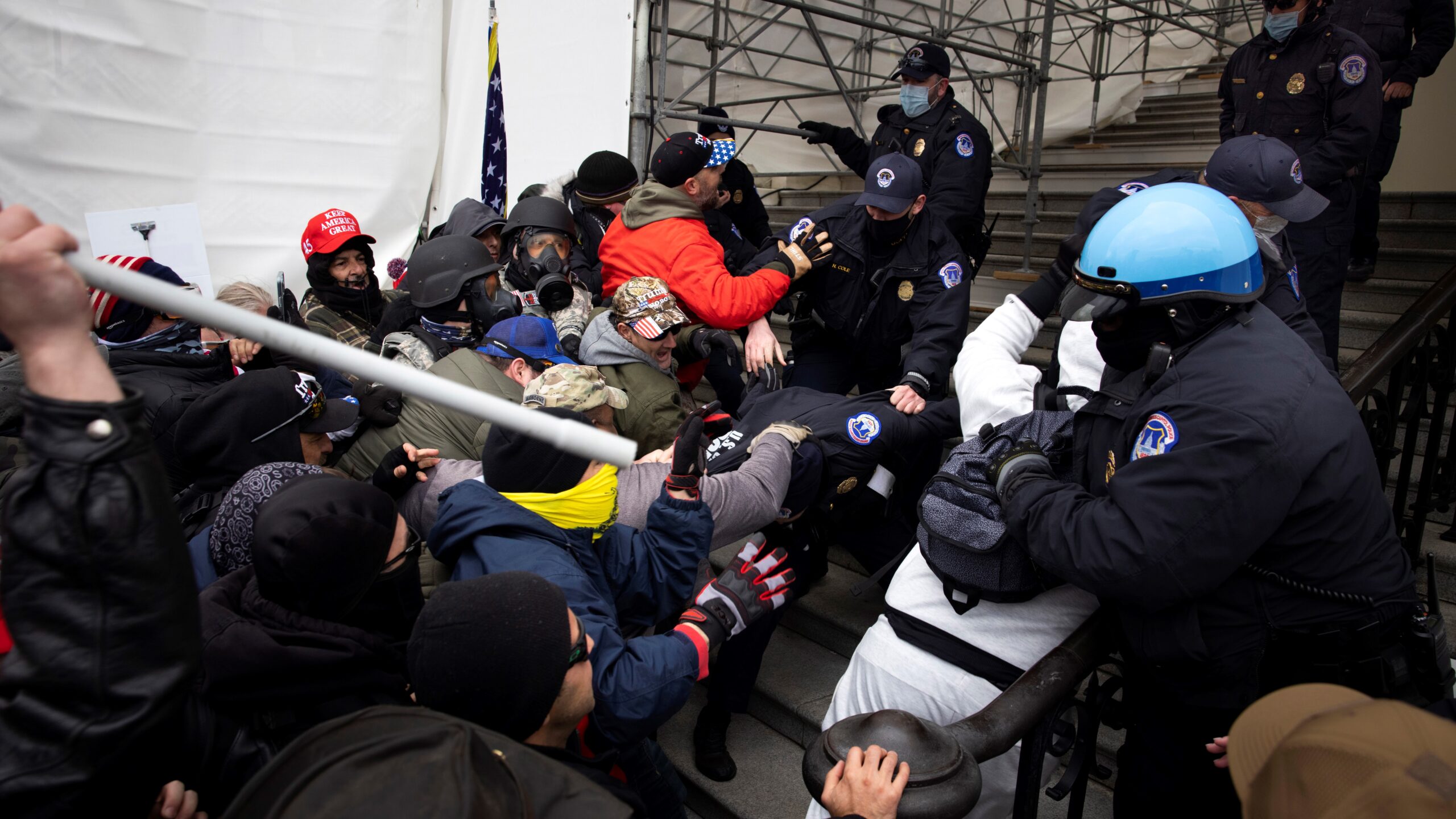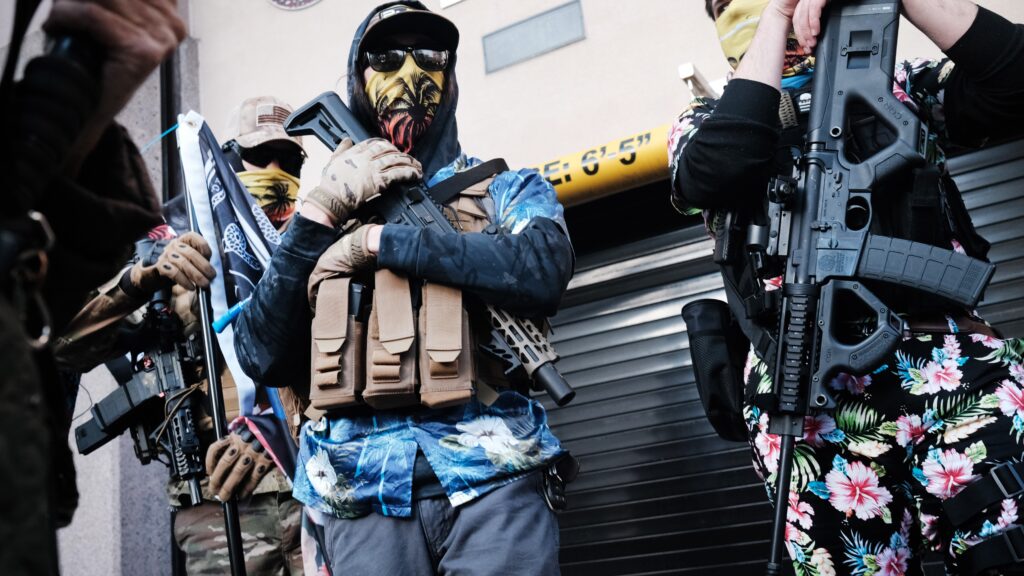
Supporters of then-President Donald Trump attack police officers during the Jan. 6 riot. (Brent Stirton/Getty Images)
On Jan. 6 2021, the nation watched as a nightmare unfolded in Washington: pro-Trump supporters rioting through the halls of Congress as lawmakers huddled for safety. Shortly after, it emerged that some servicemembers and veterans were among those attempting to disrupt the confirmation of President Joe Biden’s electoral win. Now, dealing with extremism in the military is now a top priority for Defense Department leaders, but Mark Cancian of CSIS argues below that they must confront hard decisions about defining who is and isn’t dangerous.
A year ago today, rioters stormed the US Congress in an attempt to disrupt – if not somehow overturn entirely — the outcome of the 2020 presidential election. That event raised questions about extremism among military personnel.
During his confirmation hearing, Defense Secretary Lloyd Austin identified the issue as a serious challenge for the force, saying “The job of the Department of Defense is to keep America safe from our enemies. But we can’t do that if some of those enemies lie within our own ranks.” Senior officials have made repeated statements to that effect.
One year in, DoD is getting a grip on the numbers (small) and has revised the guidance on what constitutes violent extremism. However, some critics want drastic action and the guidance, by not specifying what organizations might be prohibited, leaves individual commanders to judge what is or is not acceptable. As it stands, the department’s attempts ar staying vague with its guidance is sending defense leaders down a path for greater attention and controversy.
The Numbers
The Pentagon recently published its initial findings [PDF] on violent extremists in the military, and given how much attention the issue has engendered, the numbers are surprisingly low. The DoD Inspector General stated that there were 92 active-duty and reserve personnel “who are subject to official action due to engagement in prohibited extremist activity.” Those “official actions” were mostly administrative, with only one criminal prosecution. About one-third of the cases are still being resolved.
This number represents .005 percent of the 2.1 million active and reserve troops, or one servicemember out of every 21,000. In transmitting the report, Austin noted “The overwhelming majority of the men and women of the Department of Defense serve this country with honor and integrity. They respect the oath they took to support and defend the Constitution of the United States.”
These low numbers are not surprising given that DoD screens military personnel when recruited and has day-to-day oversight on them. Impressions about large numbers of violent extremists in the military ― and hence how serious an issue it is ― arise from how the numbers are presented. DoD focuses on active-duty and reserve personnel because they are under its control. Most analyses look at broader categories, particularly including veterans. Veterans (except retirees) are fully civilians, not being under the DoD’s control, and may be many years removed from their military service.
The January 6 riots are an illustration. Of the 727 rioters identified so far, 81 are veterans, four are reservists, and one (a Marine major) was active duty. (These numbers change frequently as the legal process unfolds.) The number of veterans is high — just over 11 percent of those identified — but that is out of 18 million veterans in the United States.
The four reservists are out of 810,000 currently serving Guard and reserve personnel. That’s one out of about 200,000. The single active-duty service member is out of 1,350,000 active-duty personnel.
Some analyses also gather data over many years, so the numbers look high. One study found that 458 personnel “associated with the military” had been arrested for extremist activities. But this was over 30 years and included active-duty personnel (rare), reservists (also rare), and veterans (by far the most numerous category).
A New Definition
With numbers out of the way, let us take a look at what the department has done since Jan. 6, which includes several responses to control violent extremism. It stood up a “Countering Extremism Working Group.” It conducted a one-day stand down to train troops on what was permitted and how to recognize extremism. It will update training for troops leaving active duty to help them resist extremist messages.
But perhaps most notable — for both its intended and potential unintended consequences — is the decision to update guidance on prohibited activities, vis DoD instruction 1325.06, “Handling Protest, Extremist, and Criminal Gang Activities among Members of the Armed Forces.”
Compared with the 2009 version, the new guidance expands the types of prohibited activities and focuses on violent and illegal actions. Most are not surprising, for example: “advocating, engaging in, or supporting terrorism within the United States or abroad…Advocating, engaging in, or supporting the overthrow of the government of the United States or any political subdivision thereof….”.
Others, however, edge toward the political and cultural realm: “Advocating widespread unlawful discrimination based on race, color, national origin, religion, sex (including pregnancy), gender identity, or sexual orientation.” And while that key term, “widespread unlawful,” would seem to require the high bar of rhetoric that incites extensive violence, the phrasing opens up a lot of gray area.
Would a statement questioning the role of transgender individuals in the military be considered “violent extremism?” The Biden administration regards discrimination against transgender people as illegal. What about a statement arguing that pregnancy hurts readiness? Discrimination against pregnant women is illegal. Such sentiments have been legitimate topics for discussion in the past, even if today official policy and most senior officials disagree.

The “boogaloo boys” group is a rare clear-cut case of “extremism” under the Pentagon’s definition. (Spencer Platt/Getty Images)
Military journals are full of articles questioning and even opposing current policies. That’s how militaries adapt to changing circumstances. Thus, how this provision is applied will be important to the intellectual life of the military services. One overzealous censor could stifle a lot of intellectual activity.
Another key term, “active participation,” has been expanded to include advocating, providing material support or resources, recruiting, training, fundraising, or knowingly communicating sensitive government information. Most of these activities fall within a commonsense definition of active participation. However, commentators have speculated that “liking” extremist materials on social media could be considered advocacy and therefore cause for disciplinary action. No one should be “liking” extremist material, but that’s only a click on social media, as opposed to other activities that involve much more time and commitment.
A major uncertainty is that the guidance does not specify which organizations the new guidance would prohibit ties with. DoD is taking the attitude towards violent extremism that the Supreme Court took towards pornography; they will know it when they see it. That was not a useful legal test for pornography, and DoD will run into the same problem. Deciding on a case-by-case basis which organizations are violent extremists and which are protected by constitutional rights to assembly and free speech is likely to be an onerous and contentious process. It just postpones difficult decisions.
Are the various “Boogaloo” organizations violent extremists? They advocate race war, hence violence. They would seem to fall under the definition. Are “Oath Keepers” a prohibited organization? They do not advocate the overthrow of the US government and say they are protecting constitutional rights. On the other hand, members have been involved in violent incidents, and their interpretation of “constitutional rights” is inconsistent with that of the Supreme Court.
Are the various “stop the steal” organizations violent extremists? Certainly, they are trying to overturn a settled election, but most don’t advocate violence. Are President Donald Trump and his political support organizations violent extremists? He continues to challenge the election results and is unrepentant about his involvement with the Jan. 6 riots, but he is a former president and supported by a large part of the US electorate.
Ongoing Challenges
DoD is in a difficult place. The numbers of violent extremists are small, indicating that current policies are generally working. That’s good. However, some legislators and commentators like Rep. Anthony Brown, D-Md., argue that “one extremist in the ranks is just one too many.” He believes that the department is denying the problem and should take more aggressive action. A recent op-ed in the Washington Post suggested establishing spying mechanisms on military bases to identify “potential mutineers.” However, this kind of aggressive surveillance risks damaging military morale and cohesion, even if legally allowable.
Senior military officials prefer a leadership and education approach, rather than a judicial approach. As Carter Ham, a retired US Army General, stated, “DoD’s plan should not be a witch hunt or a ’just throw them out’ approach. The Army has a lot invested in soldier and leader training and development.” A RAND study on extremism in the military came to similar conclusions, recommending “community-based approach that leverages existing military programs.” However, this may not be acceptable to critics like Brown, who want immediate and dramatic action.
For defense leaders, it may seem easier in the short term to keep things open-ended. But that is just kicking the can down the road. Ultimately, the department will need to get specific about which organizations and ideologies constitute “violent extremism” and which might be unsavory but covered by constitutional protections.
A narrow definition will minimize legal and political challenges by focusing on organizations that are clearly violent. However, that may not satisfy some critics who will point to the extremist language of some excluded organizations. Here DoD will run into a problem that appears on many university campuses: the belief that speech is action and therefore violent speech is the same as violent action.
A broad definition will pull in organizations that use extremist rhetoric even if not physically violent, but such broad definitions may pick up partisan overtones. They might, in theory, exclude some conservative members of Congress from military service. Without a clear list of prohibited organizations, the choice devolves on individual commanders who will come up with conflicting definitions that engender partisan controversy and legal chaos.
The issue is thus far from resolved. Department leaders should act sooner rather than later to create specific guiderails, as difficult as those discussions may be.
Mark Cancian, a member of the Breaking Defense Board of Contributors, is a retired Marine colonel now with the Center for Strategic and International Studies.
Sullivan: Defense industry ‘still underestimating’ global need for munitions
National Security Advisor Jake Sullivan said that there are “no plans” for another Ukraine supplemental at this point.

























